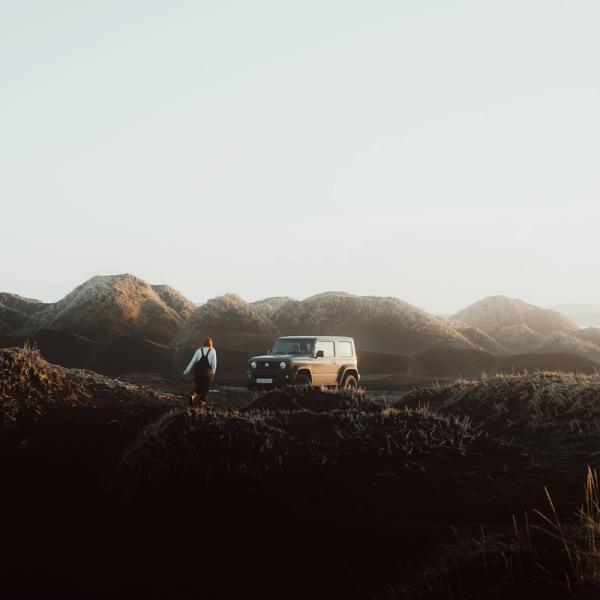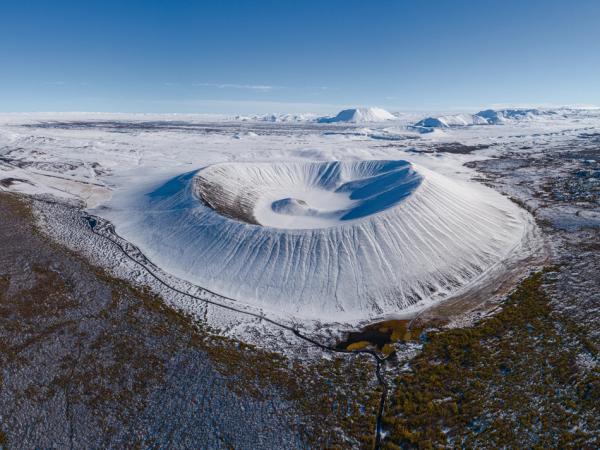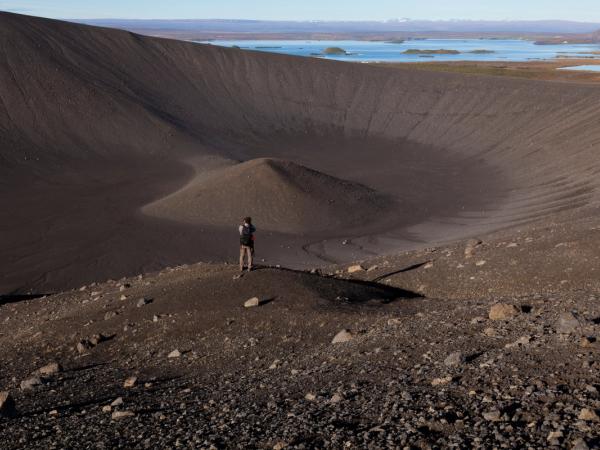
Hverfjall Volcano: Iceland's Stunning Tephra Crater
In Iceland's landscape of extremes, Hverfjall stands out as one of the country's most striking volcanic features. This huge, nearly circular crater rises from the earth like a dark crown near Lake Mývatn, creating a sharp contrast against the surrounding area. If you enjoy geology or simply like great views, Hverfjall offers a hike worth taking.
Key takeaways
- Hverfjall (also called Hverfell) is a 2,500-year-old crater in northern Iceland
- The hike to the rim takes 30-45 minutes with wide views of Lake Mývatn
- Visit between June and September for the best weather and trail conditions
- Add nearby spots like Dimmuborgir and Mývatn Nature Baths to your trip
- Stay on marked paths to protect this natural monument
What is Hverfjall?
Hverfjall is a large tephra cone that formed during a strong volcanic eruption about 2,500 years ago. It stands 452 meters above sea level with a crater roughly 1 kilometer across and 140 meters deep, making it one of the largest and best-kept volcanic craters of its kind in the world.
The name has two common spellings - Hverfjall and Hverfell - both of which you'll see on maps and signs. While some people might prefer one over the other, both names are widely used.
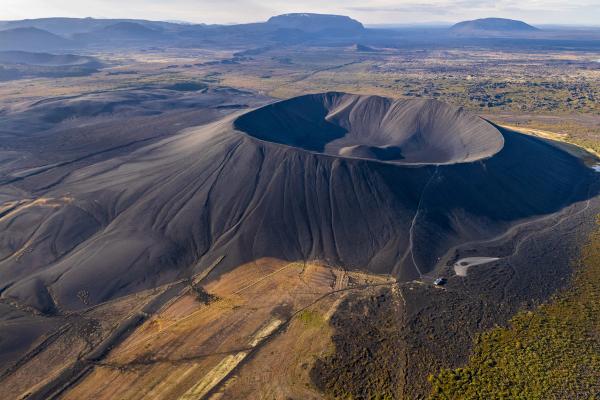
Formation & Geology
What makes Hverfjall interesting is how it formed. Unlike some volcanoes that grow slowly over time, Hverfjall was created in a single explosive event when hot magma met groundwater, causing a huge steam explosion. This type of eruption sent ash and rock pieces flying into the air, which then fell back to earth to form the cone shape we see today.
The volcano is part of the Krafla volcanic system along the Mid-Atlantic Ridge, where two tectonic plates are slowly pulling apart. This area has been active for the last 11,700 years. During Hverfjall's formation, a landslide changed the perfect shape of its southern side.
The dark color of the crater comes from basaltic rock, giving Hverfjall its unique look against the often green or snow-covered surroundings. This makes it not just important for science but also nice to look at and photograph.

Where is Hverfjall Located?
Hverfjall sits in northern Iceland, just east of Lake Mývatn in an area known for its volcanic activity. It's part of the Diamond Circle, a popular tourist route that includes other natural sites like Dettifoss waterfall and the Ásbyrgi canyon.
How to Get There
Hverfjall is not close to Reykjavik, but that doesn’t mean it’s difficult to access.
- From Reykjavík: The drive from Reykjavík to the Mývatn area takes about 6 hours via the Ring Road (Route 1). Many people break up this journey with stops along the way, or fly to Akureyri first to shorten the drive.
- From Akureyri: The drive from Akureyri to Lake Mývatn takes about 1.5 hours (90 km). Follow the Ring Road east until you reach the Mývatn area.
Once you're in the Mývatn area, take Road 848 around the eastern side of the lake. There's a small parking area at the base of Hverfjall with a restroom. The parking fee is 1,000 ISK (about $7 USD) per vehicle.
If you don't have a car, several tour companies in the area offer guided trips to Hverfjall and nearby spots. These usually start from Akureyri or the Mývatn area.
The Hverfjall Hiking Experience
Hiking Hverfjall is one of the main activities in the Mývatn area. The hike isn't technically hard, but it does require a decent level of fitness.
There are two main trails to the top:
- The northwest path - This is the most used route up. It's steep in places but generally well-kept.
- The south path - A slightly gentler slope, this path starts from the opposite side of the crater.
Both trails are marked, and it's important to stick to these paths. The volcanic soil is fragile, and walking off-trail causes damage that can take decades to heal in this delicate environment.
The hike from the parking area to the rim takes about 30-45 minutes, depending on your pace. Once at the top, you'll find a path that circles the entire crater rim, offering different views of both the crater interior and the surrounding landscape. Walking the full circle takes roughly an hour.
What makes this hike special is the contrast between the dark, moon-like landscape of the crater itself and the lively views of Lake Mývatn and the surrounding area. On clear days, you can see for miles across the volcanic landscape, including the Krafla volcano area in the distance.
I last went in May 2023 with some pals, and I enjoyed it very much.
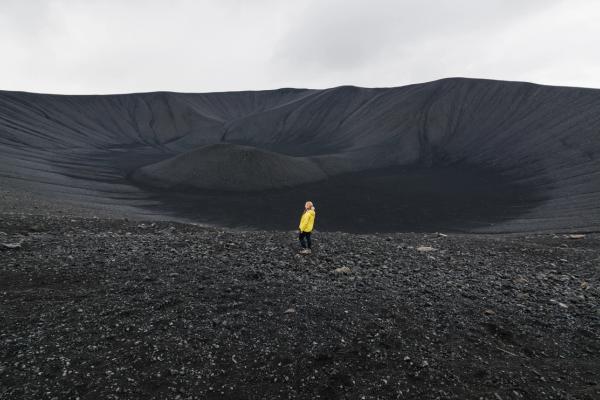
Best Time to Visit Hverfjall
Iceland's weather can change quickly, and this affects when you should plan your visit to Hverfjall.
Summer (June to August)
Summer is when most people visit, and with good reason. Temperatures are milder (though still cool, around 10-15°C or 50-59°F), daylight lasts nearly 24 hours around the summer solstice, and all trails are open. The Midnight Sun creates unique lighting for photography, and the surrounding landscape is green.
Early fall (September)
September can be ideal as the summer crowds thin out while the weather remains fairly mild. You might even see the Northern Lights if you're lucky.
Winter (November to March)
Winter offers a completely different experience. The crater and surrounding area become covered in snow, creating a stark landscape. However, hiking can be dangerous without proper gear, and some access roads may be closed. If you visit during winter, check conditions carefully and consider joining a guided tour.
Spring (April to May)
Spring brings the thaw and with it, muddy conditions. Trails might be slippery, but the landscape comes alive as the snow melts.
For photography, early morning or late afternoon light creates nice shadows across the crater. If you're shooting in summer, the "golden hour" happens very late or very early due to the Midnight Sun.
What to Wear and Bring
Like we said, Iceland's weather can change quickly, and the open landscape around Hverfjall offers little protection from wind and rain. Here's what to wear and bring:
- Layers - Even in summer, temperatures can be cool, especially at the crater rim, where wind is common. Wear a base layer, middle layer, and waterproof outer layer.
- Hiking boots - The trail can be steep and gravelly. Good hiking boots with ankle support are recommended.
- Hat and gloves - Useful year-round, a must in colder months.
- Sunglasses and sunscreen - The sun reflects off the black volcanic soil, and there's no shade on the crater.
- Water bottle - There are no facilities at the crater itself, so bring enough water for your hike.
- Camera - The views are great, and the crater's unique shape makes for good photos. A wide-angle lens helps capture the whole crater.
- Small backpack - To carry extra layers, water, and snacks.
Again, in Iceland, the weather can change in minutes. Be ready for conditions to shift rapidly, especially in spring and fall.

Must-Visit Attractions Near Hverfjall
The Lake Mývatn area has many natural wonders, making it worth spending at least a full day (ideally 2-3) exploring the region. Here are some highlights near Hverfjall:
Dimmuborgir
Just a short drive from Hverfjall, Dimmuborgir (meaning "Dark Castles") is a maze of unusual lava formations created about 2,300 years ago. According to stories, these twisted towers and caves are home to the Icelandic Yule Lads and the troll Grýla. Several marked paths wind through the formations, ranging from 15 minutes to over an hour. The area has bathrooms and a small café.

Mývatn Nature Baths
After hiking Hverfjall, relax your muscles at the Mývatn Nature Baths, often called the "Blue Lagoon of the North." This geothermal spa offers milky-blue waters rich in minerals, with temperatures ranging from 36-40°C (96-104°F). It's less crowded and less expensive than its famous southern counterpart, with adult admission at 7,400 ISK ($60 USD). The views of the surrounding landscape from the baths are excellent.
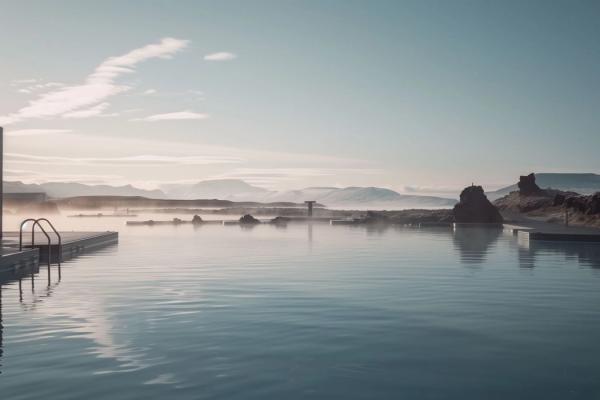
Hverir Geothermal Area
East of Mývatn, the Hverir geothermal area (also called Námaskarð) features bubbling mud pots, steaming vents, and a landscape painted in reds, oranges, and yellows from mineral deposits. The barren, Mars-like terrain with its hissing steam creates an unusual atmosphere. There is a strong sulfur smell, but it's part of the experience!
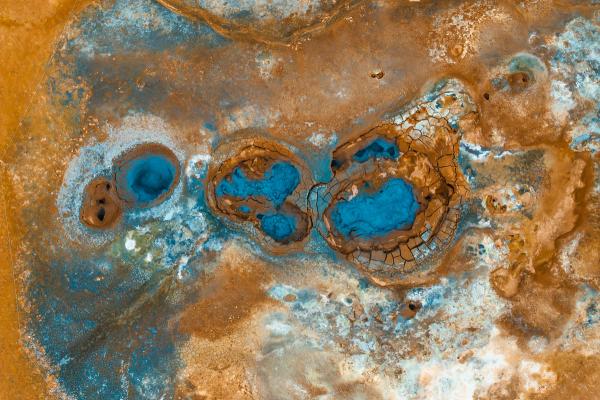
Grjótagjá Cave
This small lava cave contains a clear blue hot spring that was used as a filming location for Game of Thrones. While swimming is no longer allowed due to unstable water temperatures, it's still worth visiting to see the blue water. It’s located between Hverfjall and Dimmuborgir, so it's easy to add to your itinerary.
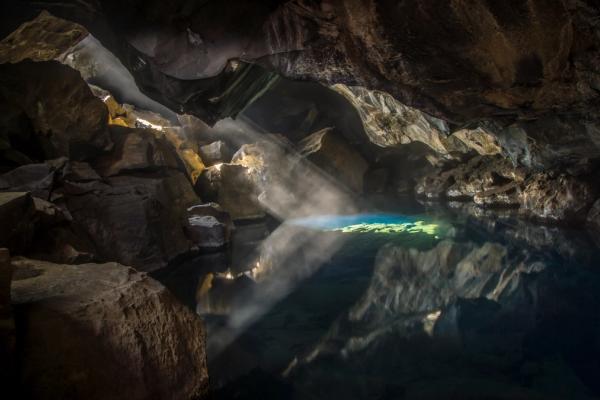
Krafla Volcanic Area
About 20 minutes from Hverfjall, the active Krafla volcanic area features the Víti crater with its green lake, as well as the Leirhnjúkur lava fields, where you can walk among steaming vents and recently cooled lava (the last eruption period was 1975-1984). The area also has a geothermal power plant that provides electricity to much of northern Iceland.
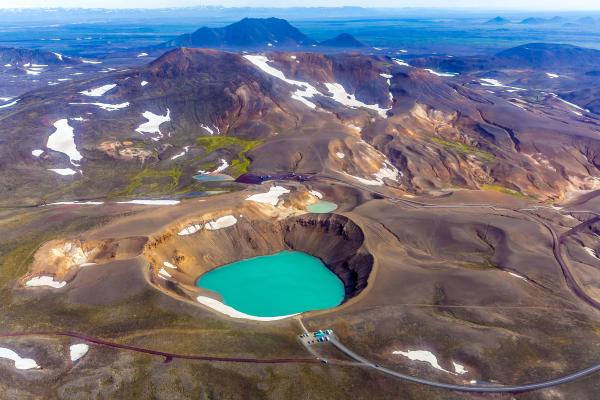
Skútustaðagígar Pseudocraters
On the southern shore of Lake Mývatn, these odd formations look like volcanic craters but were created when lava flowed over wetlands, causing steam explosions. A walking trail lets you explore these unique features while enjoying views of the lake and its birds.
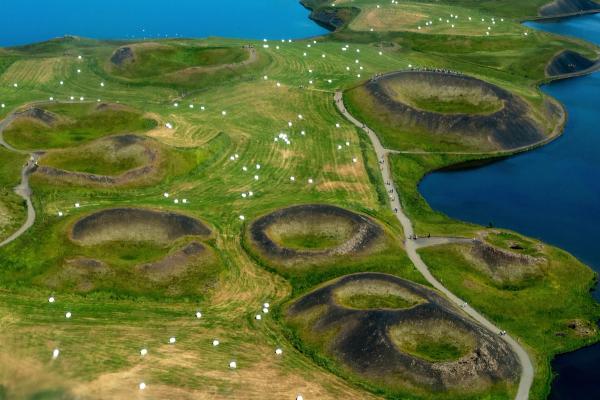
Where to Stay Near Hverfjall
The Lake Mývatn area offers various places to stay, though they can fill up quickly in summer, so booking ahead is essential.
Hotels and Guesthouses:
- Fosshotel Mývatn provides a more upscale option with a good restaurant
- Vogafjós Farm Resort combines accommodation with a working farm and restaurant, where you can taste local produce
- Dimmuborgir Guesthouse offers cozy rooms close to the lava formations
Budget Options:
- Hlíð Hostel provides dormitory and private rooms at more affordable rates
- Camping is available at Bjarg Campsite near the lake from June to September
Prices vary by season, with peak summer rates (June-August) often double what you might pay in spring or fall. Most accommodations include breakfast, and many have restaurants, which is useful as dining options in the area are somewhat limited.
Staying in the Mývatn area rather than making a day trip from Akureyri allows you to see the landscape in different lights and gives you more time to explore at a slower pace.
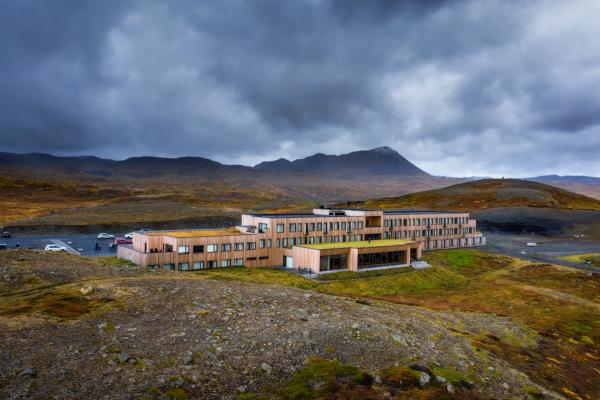
Conclusion
Hverfjall shows Iceland's volcanic power, a reminder of the forces that have shaped this remarkable island. The relatively easy access and moderate hike make it accessible to most visitors, while the views reward the effort many times over.
When planning your trip to Iceland, don't rush through the north just to get back to Reykjavík. The Lake Mývatn area deserves at least a couple of days to fully appreciate its diverse attractions, with Hverfjall being a highlight that combines natural history, exercise, and views in one memorable experience.

